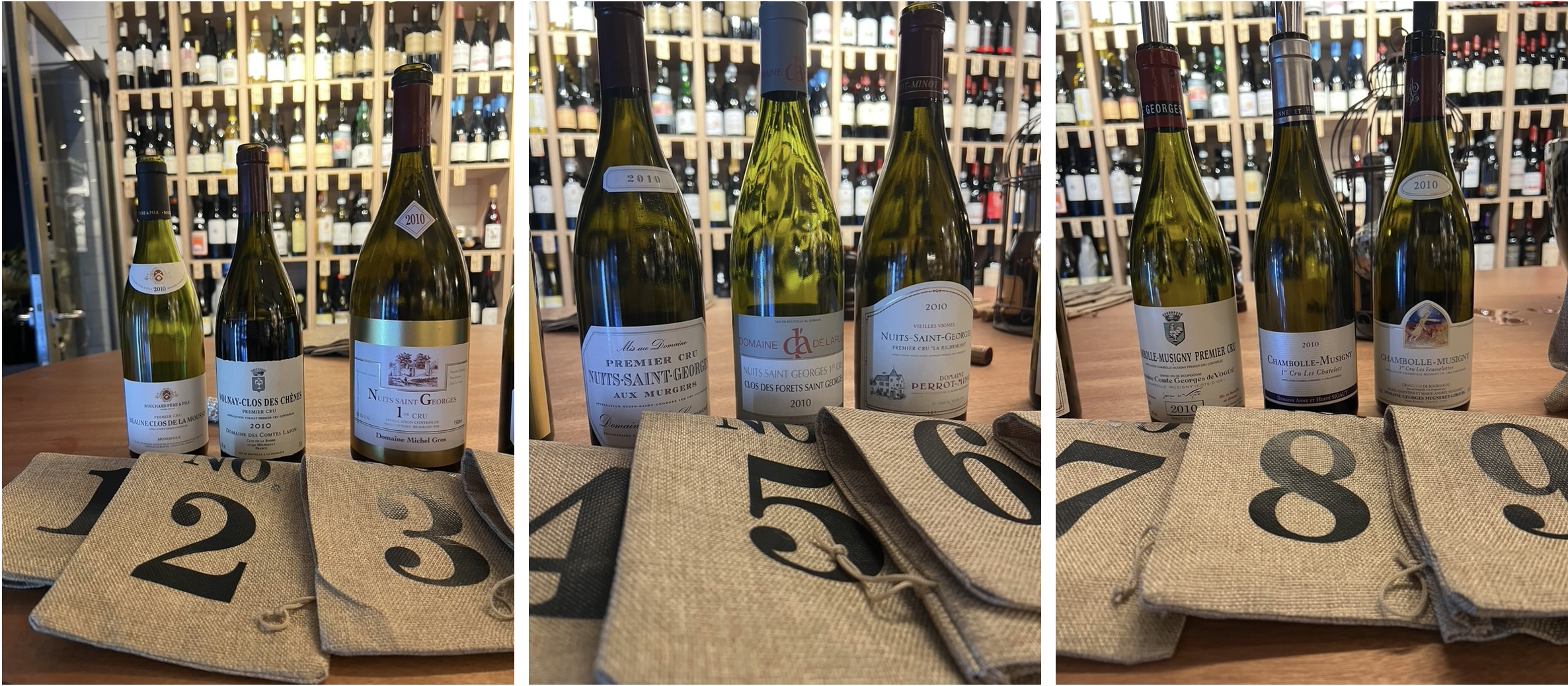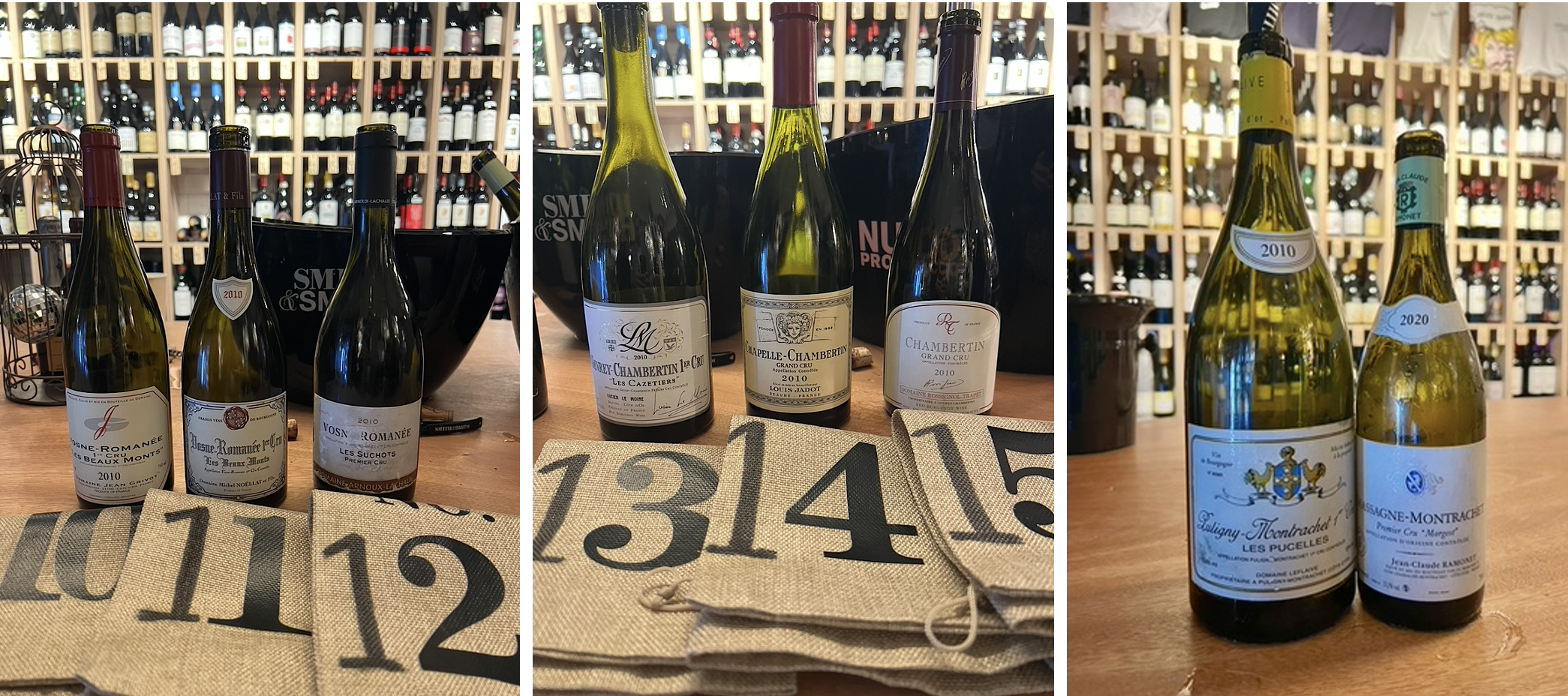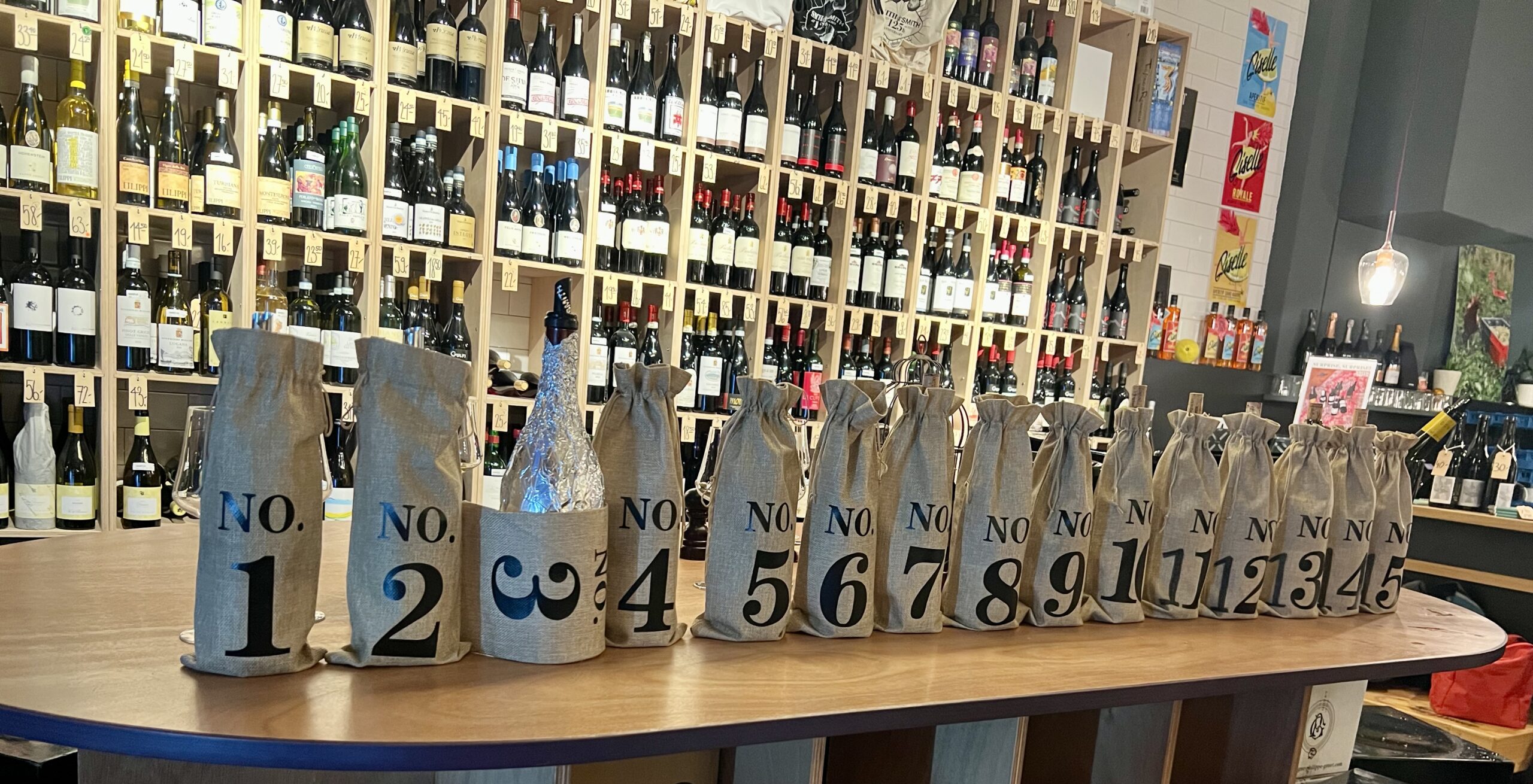At 15 years of age, 2025 feels like the perfect moment to check in and see if the hype about the heralded 2010 Burgundy vintage holds up. With the Grands Crus still demanding patience, we opted for a lineup of 2010 Premier Cru reds, spread across villages, styles, and philosophies. All bottles were tasted blind.
The 2010 Signature: Lift, Line, and Transparency
The overall performance was quite strong. Standouts like Grivot’s Les Beaux Monts and Méo-Camuzet’s Aux Murgers showcased the best qualities of the vintage: aromatic purity, precision, and fine structure, all wrapped in juicy acidity and seamless tannins, with impressive site transparency. Many wines shared a common thread of medicinal lift, menthol, and chalky minerality, likely reflecting the vintage’s high acidity and slow ripening curve. These notes added character and freshness.
The Limits of Modern Winemaking
A few modern-leaning wines such as Sigaut and Perrot-Minot leaned too heavily on ripeness, extraction, and oak, a stylistic choice that has not aged well. Wines made in this style rarely age gracefully, not in Burgundy, not in Bordeaux or anywhere else.
Patience Required
The broader showing confirmed that 2010 is a vintage with a slow aging curve. Most wines still appeared young and vibrant, with little to no tertiary development. The two Grand Cru wines included in the lineup reinforced that impression, as both remained quite closed, only hinting at their potential. My guess is that the Premier Crus will need another five to ten years, even though many already offer great drinking pleasure today. The Grands Crus will likely need more than a decade more to fully unfold.
Results: Group Voting – Top 5
| Group Rank | Wine |
| 1 | Jean Grivot Vosne-Romanée 1er Cru Les Beaux Monts |
| 2 | Lucien Le Moine Gevrey-Chambertin 1er Cru Les Cazetiers |
| 3 | Rossignol-Trapet Gevrey-Chambertin Grand Cru Chambertin (Ringer) |
| 4 | Comte de Vogüé Chambolle-Musigny 1er Cru |
| 5 | Mugneret-Gibourg Chambolle-Musigny 1er Cru Les Feusselottes |
Tasting Notes
Aperitif
2010 Leflaive Puligny-Montrachet 1er Cru Les Pucelles, 96 points
From Magnum. The only white in the lineup and from a difficult era for Leflaive (premox). Luckily, this bottle showed great. The nose immediately delivers classic Pucelles charm with deep aromas of stone fruit, citrus, and chalky minerality. On the palate, the wine is already quite complex and texturally refined, gliding effortlessly with crystalline minerality and vibrant 2010 freshness holding everything in perfect check. While it may still develop further Grand Cru-level complexity, in every other aspect this shows as Grand Cru in quality, even if not in name.
Flight 1
2010 Bouchard Beaune 1er Cru Clos de la Mousse, 90 points
The nose is medium expressive, offering delicate medicinal notes, darker red fruit, and some minerality over time. The palate features fine red and darker berries, along with plenty of acidity and minerality. The wine is fresh and round, but lacks a bit of sweetness and mid-palate weight, leading to a slightly shortened finish. Overall, simple but well-made, with the attack and medicinal nuance as highlights.
2010 Comtes Lafon Volnay 1er Cru Clos des Chênes, not rated
This was badly corked.
2010 Michel Gros Nuits-Saint-Georges 1er Cru, 92 points
From magnum. The nose is a bit muted and dusty. On the palate, the wine opens beautifully with strawberries, spices, minerality, and a subtle medicinal note. There is good complexity and a fresh minty lift, though the structure remains slightly muscular toward the back. Still youthful, and while it may not reach the depth or finesse of the top wines, it is nicely balanced, without fault, and drinking well.
Flight 2
2010 Méo-Camuzet Nuits-Saint-Georges 1er Cru Aux Murgers, 94 points
The nose is refined and inviting, with red fruit, menthol, spices, and minerality. The palate is superb, offering fine red fruit, floral notes, hints of blue fruit, and precise minerality. The wine is elegant, round, and complex, with a superb balance and modern touch, but no excess in any category. The ripeness is kept in check and the Vosne-like silkiness of Aux Murgers is on full display. This was easily one of the top wines of the lineup thanks to its balance, complexity, and precision. 94/95pts.
2010 L’Arlot Nuits-Saint-Georges 1er Cru Clos des Forêts, 88 points
The nose is dusty and not very precise. The palate is more promising, showing minerality, herbs, smoke, and some fruit, but overall it lacks definition and feels a bit hollow on the mid-palate. The structure has hard edges, making it feel unresolved. Usually, a great value for money choice, this was quite disappointing. Some felt this may not have been a representative bottle. Others, who know much more than I do, mentioned that there has been a leap in quality after Geraldine Godot took over the winemaking in 2014.
2010 Perrot-Minot Nuits-Saint-Georges 1er La Richemone Vieilles Vignes, 91 points
The nose is toasty and ripe, with leather and dark fruit. On the palate, the wine shows ripe red berries, though slightly overripe, with green hints and medicinal notes. The style leans more cellar-driven, not for purists. Already showing some evolution, suggesting it may be at peak now, with limited upside. This was one of the more modern, riper, and extracted wines and to me this is another proof that wines with this style don’t have a particularly long lifespan.

Flight 3
2010 Comte de Vogüé Chambolle-Musigny 1er Cru, 91 points
The nose is ripe and kirsch-driven, with a hint of alcohol. The palate is very ripe, with kirsch fruit, herbs, and minerality, delivered with laser-sharp precision and superb acidity. The structure is pure Chambolle, light and airy, but the fruit profile is a bit too ripe for the appellation and my taste. Technically impressive but stylistically polarizing.
2010 Hervé Sigaut Chambolle-Musigny 1er Cru Les Chatelots, 81 points
The nose shows clear oxidation and stewed fruit, indicating advanced evolution. On the palate, drying tannins and tired fruit dominate the profile. While not completely dead, the wine is clearly past its prime. This bottle underscores the ageability issue for red Burgundy when ripeness, extraction, and oak use are pushed too far. I’ve recently had a few bottles of this producer and I’m happy to report that they no longer seem to be on the dark side. The wine appear less ripe and extracted and should age more gracefully.
2010 Mugneret-Gibourg Chambolle-Musigny 1er Cru Les Feusselottes, 93 points
The nose is currently subdued, offering limited aromatic expression. On the palate, however, the wine shines, showcasing superb floral lift, fine red fruits, and delicate spice, all carried by an elegant, airy frame. The structure is light and precise, though at this stage the wine lacks the complexity and aromatic openness required for a higher score. It clearly needs at least five more years in the cellar to unfold. Still, it was unmistakable why Mugneret-Gibourg is so revered: no other wine in the lineup felt as ethereal.
Flight 4
2010 Jean Grivot Vosne-Romanée 1er Cru Les Beaux Monts, 96 points
The most captivating nose of the lineup: classic Burgundy perfume with a mix of red and dark fruits, sous bois, stony minerality, and a wisp of smoke. The palate is brighter and more delicate, unfolding layers of red berries in all forms, floral nuances, fresh herbs, spice, and a touch of whole-cluster character. It’s complex and finely etched, expanding seamlessly from the initial attack to a long, persistent finish. Textbook Vosne-Romanée and already wide open and the unanimous wine of the night for its purity, flawlessness, and expressive charm. Yes, there’s a modern edge, but it’s executed with restraint and precision, free of any excess. 96/97pts.
2010 Michel Noëllat Vosne-Romanée 1er Cru Les Beaux Monts, 92 points
The nose is muted and lacks definition. On the palate, the wine is much more expressive, with a sweet ripe fruit core, minerality, a touch of toast, and a fine frame with good freshness. Medicinal herbs lend an extra layer of complexity and freshness. With a few more years, the nose should open up, lifting the wine to a higher level but this was a lot of fun to drink today.
2010 Arnoux-Lachaux Vosne-Romanée 1er Cru Les Suchots, not rated
The bottle was completely corked, making it impossible to assess the wine’s substance.

Flight 5
2010 Lucien Le Moine Gevrey-Chambertin 1er Cru Les Cazetiers, 94 points
The bouquet is intoxicating. Ever-evolving and delivered with remarkable precision, featuring ripe red berries, stems, minerality, and a faint touch of reduction. On the palate, the wine is layered and finely delineated, revealing kirsch, red berries, savory herbs, toast, and stony minerality, with a subtle echo of reduction throughout. Tannins are silky, the freshness is vibrant, and the texture is satin-like. There’s impressive depth and substance here, though the wine remains a touch untamed and will benefit from a few more years to fully harmonize. As is typical for Le Moine, this is a modern, polished or glossy expression of Burgundy and one that may not appeal to purists, but the upside is clear: if it weren’t made in this style, pricing would likely render these wines out of reach.
2010 Louis Jadot Gevrey-Chambertin Grand Cru Chapelle-Chambertin, 92 points
Grand Cru Ringer. As expected from a Grand Cru of this stature, the wine is not yet fully open. The nose remains closed and marked by reduction, but the palate already reveals impressive depth and laser-like precision, with a sweet fruit core firmly in place. The structure is impeccable, though the components have yet to fully harmonize. It will need another decade to reach its stride. Both Gevrey Grand Crus in the lineup showed great promise and already some drinking pleasure but should reach far higher highs in the future. 92/93pts.
2010 Rossignol-Trapet Gevrey-Chambertin Grand Cru Chambertin, 93 points
Grand Cru Ringer. The wine required time and air to emerge. Initially muted, reductive, and closed, it gradually opened but never fully. The nose leaned dark and dense, and the palate mirrored that, starting off a bit wild, with natural wine tones, before transitioning into something more classic. Deep fruit core, minerality, and herbs emerged with time. The tannins are impeccable, and the freshness is excellent. A promising Chambertin that should blossom with another 5 to 10 years. Both Gevrey Grand Crus in the lineup showed great promise and already some drinking pleasure but should reach far higher highs in the future. 93/94pts.
Author: Andy Schnyder
March 2025


